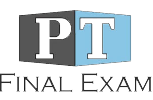Sample Question (taken from an actual patient of mine)
An 11 year old male presents to your clinic with signs of hypertonicity related to cerebral palsy. The boy has significant shortening of the left sternocleidomastoid muscle, creating a severe torticollis to the right. This has led to a pressure ulcer forming on his right ear from contact with the wheelchair headrest. The MOST appropriate course of action is to:
- Begin a course of active-assisted range of motion exercises, focusing on the upper extremities and creating a home program to improve shoulder active range of motion.
- Inform the patient’s family that the child should be on bed rest to prevent the formation of any more pressure ulcers and decrease pain associated with torticollis.
- Immediately call the primary care provider of the child and inform him/her to order an oral prescription of Baclofen because the child has developed a tolerance for the current dosage.
- Begin a course of passive range of motion stretches, focusing on the neck, and instruct the patient’s family on proper positioning and wheelchair adjustments to decrease the likelihood of future ulcers.
The correct answer is: ?
- This is a distractor option that does not address torticollis or ear ulceration. While shoulder range of motion exercises may not be harmful or cause problems, it certainly won’t solve this one.
- This will solve the ulceration problem, but when does a physical therapist ever put a patient on bed rest? This is not the MOST appropriate course of action.
- Getting an increase dosage of Baclofen may be part of the solution, but there are several issues with this item. If the patient is affected enough to develop ulceration from positioning, he likely won’t be able to tolerate oral Baclofen (he will have to receive it intrathecally). Also, Baclofen use does not generally create tolerance to the drug requiring higher doses.
- This is the MOST correct answer. It is straightforward in describing a course of action that focuses on treating the hypertonic neck muscles, but also addresses positioning and family/patient education.
